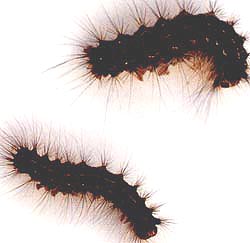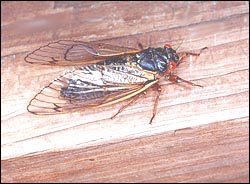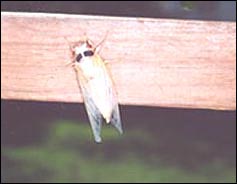곤충 물림, 나방, 모충에 의한 피부염, Dermatitis due to insect bites, butterflies and larva
곤충 물림, 나방, 모충에 의한 피부염의 개요, 증상 징후
-
쐐기벌레는 나비의 유충이다. 유충은 대추나무의 잎이나 다른 종류의 나무의 잎을 먹고 산다.
-
쐐기벌레의 털에 피부가 스칠 때 털이 피부에 박힐 수 있다.
-
어떤 종류의 나방이의 털이나 쐐기벌레의 털, 유충의 털이 피부에 박히면 심하게 가렵거나 아플 수 있고 피부염이 생길 수 있다.
-
이때 생긴 피부염의 경계는 비교적 뚜렷하고 가렵고 화끈거린다.
-
피부의 표면 위쪽으로 조금 솟아 나온 피부 발진, 두드러기, 물집이 잡힌 피부 발진 등 여러 형태의 피부 발진이 생길 수 있다.
-
피부 발진의 중앙 부분의 피부가 괴사될 수 있다.
-
심한 경우, 나방이 털이나 쐐기벌레의 털에 접촉된 피부가 붓고 아프고 감각이 무디고 심한 두통 고열 구토 근육통 경련 쇼크 등 전신 알레르기 반응도 생길 수 있다.
-
쐐기벌레의 털이나 나방이의 털이 피부에 박혀 국소에 피부염이 생기고 그와 동시에 다른 부위의 피부로 퍼져 그 부위에 피부염을 일으킬 수도 있다.
-
쐐기벌레의 털이나 나방이의 털이 눈에 들어가면 결막염이 생길 수 있다.
곤충 물림, 나방, 모충에 의한 피부염의 진단
-
병력, 증상 징후와 진찰소견 등을 종합해서 진단할 수 있다.
-
쐐기벌레의 털이나 나방이의 털에 피부가 접촉 된 사실이 있으면 진단하기 쉬우나 그런 병력을 잘 모를 때는 확실히 진단하기가 어렵다.
-
피부에 박힌 나방이나 쐐기벌레의 털을 긁어 그 피검 물을 현미경으로 검사해서 진단할 수 있다.
곤충 물림, 나방, 모충에 의한 피부염의 치료 및 예방
-
특효약도 없고 특별한 치료 방법도 없다.
-
가려운 증상 징후는 베나드릴(Benadryl) 등 경구용 1세대 항히스타민제로 치료하거나 타이레놀 등 진통제로 치료 할 수 있다.
-
엘리콘(Elicon cream or Elicon ointment/베타메타손) 또는 다른 종류의 코르티코스테로이드제 연고나 크림 등으로 국소 도포해 치료 할 수 있다.
-
이런 약물이 없을 때는 가려운 상처를 찬물찜질이나 얼음물찜질로 치료하면 훨씬 덜 가려울 수 있다.
-
나방의 털이나 쐐기벌레의 털이 피부에 박힌 후 가려우면 끈적거리는 스카치테이프를 가려운 피부에 붙였다 바로 떼면 피부에 박힌 곤충의 털이 묻어 뽑혀 나올 수 있다.
-
전신 알레르기 반응으로 증상 징후가 심하게 생기면 병원 응급실 응급치료를 받아야한다.
-
들이나 산에 나가기 전에 곤충이 몸에 달라붙지 않고 곤충 교상을 예방하는 것이 중요하다. 그런 목적으로 쓰이는 구제제(Repellent)에는 여러 종류가 있다. 그 중 피부에 바를 수 있는 구제제는 10% 농도나 그 이하 농도 DEET(Diethyltoluamide)가 가장 효과 있다. 옥외로 나가기 바로 전에 옷에 뿌려 구충하는데 쓰는 Permethrin이 가장 효과있다.(출처; Infectious disease in children, August 2005, p.3).
-
Permethrin을 무명옷에 한번 뿌린 후 5번 세탁하든지 5번 드라이클리닝해도 구제제 효력이 있다.
-
모기장이나 슬리핑 백, 텐트 등에 뿌려 모기가 물지 않게 예방 할 수 있고 모기향 등으로 구제시킬 수 있다.
-
모자를 쓰고 긴소매가 달린 옷이나 긴 바지를 입어 곤충에 물리지 않게 예방할 수도 있다.
-
Permethrin의 상품명에는 Sawyer 등이 있다.

▴ 사진 387. 유충의 털이 피부염을 일으킬 수 있다. Copyright ⓒ 2011 John Sangwon Lee, MD., FAAP

▴ 사진 388. 15년 워싱턴 매미는 무해한 곤충이다.
워싱턴 D.C.에서. Copyright ⓒ 2011 John Sangwon Lee, MD., FAAP

▴ 사진 389. 15년 워싱턴 매미는 무해한 곤충이다.
워싱턴 D.C.에서. Copyright ⓒ 2011 John Sangwon Lee, MD., FAAP
Dermatitis due to insect bites, butterflies and larva
곤충 물림, 나방, 모충에 의한 피부염
Overview of dermatitis caused by insect bites, moths and caterpillars, symptoms, and signs
- Caterpillars are the larvae of butterflies.
- The larvae live on the leaves of jujube trees or other types of trees.
- When the caterpillar’s fur is rubbed, the fur can get stuck in the skin.
- If the hairs of certain types of moths, caterpillars, or larvae get stuck on the skin, it may be severely itchy or painful, and dermatitis may occur.
- The boundary of dermatitis produced at this time is relatively clear and itchy and hot.
- Various types of skin rash may occur, such as a skin rash that protrudes slightly above the surface of the skin, hives, and blistering skin rash.
- The skin in the central part of the skin rash can become necrotic.
- In severe cases, the skin in contact with the moth’s hair or caterpillar’s hair may be swollen, painful, numb, severe headache, high fever, vomiting, muscle pain, cramps, and other systemic allergies.
- Caterpillar hair or moth hair can be lodged in the skin, causing local dermatitis, and at the same time, spreading to other areas of the skin, causing dermatitis in that area.
- Conjunctivitis can occur if caterpillar hair or moth hair gets into your eyes.
Diagnosis of dermatitis caused by insect bites, moths, and caterpillars
- The medical history, symptoms, signs, and examination findings can be combined and diagnosed.
- It is easy to diagnose if there is skin contact with caterpillar hair or moth hair, but it is difficult to diagnose with certainty when such a medical history is unknown.
- It can be diagnosed by scraping the hair of a moth or caterpillar embedded in the skin and examining the specimen under a microscope.
Treatment and prevention of dermatitis caused by insect bites, moths, and caterpillars
- There are no special drugs and no special treatment methods.
- Itchy symptoms can be treated with oral first-generation antihistamines such as Benadryl or pain relievers such as Tylenol.
- It can be treated by topically applying Elicon cream or Elicon ointment (betamethasone) or other types of corticosteroid ointments or creams.
- In the absence of these drugs, the itchy wound can be treated with cold or ice water to make it much less itchy.
- If the moth’s hair or caterpillar’s hair is stuck in the skin and it is itchy, sticky scotch tape is attached to the itchy skin, and if it is removed immediately, the hair of the insect is stuck on the skin can be buried and pulled out.
- If symptoms are severe due to a systemic allergic reaction, you should seek emergency treatment at the hospital’s emergency room.
- It is important to prevent insect bites and prevent insects from sticking to the body before going out to the fields or mountains.
- There are several types of Repellents used for that purpose. Among them, DEET (Diethyltoluamide) at a concentration of 10% or less is the most effective as remedy that can be applied to the skin.
- Permethrin, which is sprayed on clothes just before going outdoors, and used to repel insects, is the most effective (source; Infectious disease in children, August 2005, p.3).
- Permethrin can be sprayed once on cotton clothes and then washed 5 times or dry cleaned 5 times to have a remedying effect.
- You can prevent mosquito bites by spraying them on mosquito nets, sleeping bags, tents, etc., and can be remedied with mosquito repellent.
- You can also prevent insect bites by wearing a hat and wearing long sleeves or long pants. Permethrin’s brand name includes Sawyer, etc.

▴ Picture 387. The hair of larvae can cause dermatitis. Copyright ⓒ 2011 John Sangwon Lee, MD., FAAP

▴ Photo 388. The 15th year Washington cicada is a harmless insect. In Washington D.C. Copyright ⓒ 2011 John Sangwon Lee, MD., FAAP

▴ Photo 389. The 15th year Washington cicada is a harmless insect. In Washington D.C. Copyright ⓒ 2011 John Sangwon Lee, MD., FAAP
출처 및 참조 문헌 Sources and references
- NelsonTextbook of Pediatrics 22ND Ed
- The Harriet Lane Handbook 22ND Ed
- Growth and development of the children
- Red Book 32nd Ed 2021-2024
- Neonatal Resuscitation, American Academy Pediatrics
Emergency Medical Service for Children, By Ross Lab. May 1989. p.10
Emergency care, Harvey grant, and Robert Murray
Emergency Care Transportation of Sick and Injured American Academy of Orthopaedic Surgeons
Emergency Pediatrics A Guide to Ambulatory Care, Roger M. Barkin, Peter Rosen
Quick Reference To Pediatric Emergencies, Delmer J. Pascoe, M.D., Moses Grossman, M.D. with 26 contributors
Manual of Emergency Care
응급환자관리 정담미디어
소아가정간호백과-부모도 반의사가 되어야 한다, 이상원 저
The pregnancy Bible. By Joan stone, MD. Keith Eddleman, MD
Preparation for Birth. Beverly Savage and Dianna Smith
임신에서 신생아 돌보기까지. 이상원
Breastfeeding. by Ruth Lawrence and Robert Lawrence
The Johns Hopkins Hospital, The Harriet Lane Handbook, 18th edition
Red book 29th-31st edition 2021
Nelson Text Book of Pediatrics 19th-21st Edition
Infectious disease of children, Saul Krugman, Samuel L Katz, Ann A. Gershon, Catherine Wilfert
The Harriet Lane Handbook 19th Edition
Growth and Development of Children, George H. Lowrey 8th edition
소아과학 대한교과서
제1권 소아청소년 응급의료 참조문헌과 출처
Other
Copyright ⓒ 2015 John Sangwon Lee, MD., FAAP
“부모도 반의사가 되어야 한다”-내용은 여러분들의 의사로부터 얻은 정보와 진료를 대신할 수 없습니다.
“The information contained in this publication should not be used as a substitute for the medical care and advice of your doctor. There may be variations in treatment that your doctor may recommend based on individual facts and circumstances. “Parental education is the best medicine.”